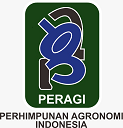Use of PGPR (Plant Growth Promoting Rhizobacteria) to Increase Yields of Cayenne Pepper (Capsicum frutescens L.) in Monoculture Planting Systems and Under the Shade of Mature Citrus Plants
Abstract
Cayenne pepper is a vegetable commodity, which can be categorized as a commercial commodity and has the potential to be developed. The problem that arises is that more and more agricultural land is getting damaged. One effort to overcome this problem is to use organic fertilizers such as PGPR. The purpose of this study was to obtain the optimum dose of PGPR (Plant Growth Promoting Rhizobacteria) on the growth and yield (quantity and quality) of cayenne pepper in a monoculture cropping system and under the shade of mature citrus trees. The research was conducted in a Citrus Orchard, Tegalgondo Village, Karangploso District, Malang Regency. The time of the research was carried out in December 2022 - March 2023. This study used a Randomized Block Design (RBD) with two factors, namely the concentration of PGPR (Plant Growth Promoting Rhizobacteria) and the planting system. The first factor is the treatment of the application of the planting system which consists of 2 levels, namely MN (Monoculture) TS (Under the Orange Shade). The second factor was the treatment of PGPR concentration consisting of 4 levels, namely, P0 (without PGPR), P10 (10 ml.-1 concentration), P20 (20 ml.-1 concentration), P30 (30 ml.-1 concentration) and Treatment randomized in each group. and cropping system treatment. The results showed that there was no real interaction between the cropping system and PGPR on the growth of cayenne pepper plants. This is because there is a different effect on each treatment.
Keywords
Full Text:
PDFReferences
Agbodjato, N. A., Noumavo, P. A., Adjanohoun, A., Agbessi, L., & Baba-Moussa, L. (2016). Synergistic Effects Of Plant Growth Promoting Rhizobacteria And Chitosan On In Vitro Seeds Germination, Greenhouse Growth, And Nutrient Uptake Of Maize (Zea mays L.) . Biotechnology Research International, 2016(I), 1–11. Https://Doi.Org/10.1155/2016/7830182
Ambar Dewi, N., E. Widaryanto and YBS Heddy. 2017. The effect of shade on the growth and yield of three varieties of cayenne pepper (Capsicum frutescens L.). J. Plant Production. 5 : 1755-1761.
Andriany, A., F. Fahruddin and A. Abdullah. 2018. The Effect of Bioactivator Types on the Decomposition Rate of Teak Leaf Litter Tectona grandis Lf, in the Unhas Tamalanrea Campus Area. J. Makassar Biology. 3(2) : 31-42.
Chandran, H., Meena, M., & Swapnil, P. (2021). Plant Growth-Promoting Rhizobacteria As A Green Alternative For Sustainable Agriculture. Sustainability (Switzerland), 13(19), 1–30. Https://Doi.Org/10.3390/Su131910986
Hendriyatno, F., Okalia, D., & Mashadi, -. (2020). The Effect of Cattle Urine Poc on the Growth of Betara Betel (Areca catechu L.) Seedlings. Agro Bali: Agricultural Journal, 2(2), 89–97. Https://Doi.Org/10.37637/Ab.V2i2.412
Kuan, K. B., Othman, R., Rahim, K. A., & Shamsuddin, Z. H. (2016). Plant Growth-Promoting Rhizobacteria Inoculation To Enhance Vegetative Growth, Nitrogen Fixation And Nitrogen Remobilisation Of Maize Under Greenhouse Conditions. Plos One, 11(3), 1–19. Https://Doi.Org/10.1371/Journal.Pone.0152478
Lidya, E. (2019). On the Growth and Yield of Cucumber Plants (Cucumis sativus L.) Organic Misano F1 Varieties Can Improve Namely: Produced By Pt Natural Nusantara And Specially Designed Especially And The Concentration Of Appropriate Poc Nasa. XVIII(D), 231–240.
López-Marín, J., Gálvez, A., González, A., Egea-Gilabert, C., & Fernández, J. A. (2012). Effect Of Shade On Yield, Quality And Photosynthesis-Related Parameters Of Sweet Pepper Plants. Acta Horticulturae, 956(June), 545–552. Https://Doi.Org/10.17660/Actahortic.2012.956.65
Minaxi, Saxena, J., Chandra, S., & Nain, L. (2013). Synergistic Effect Of Phosphate Solubilizing Rhizobacteria And Arbuscular Mycorrhiza On Growth And Yield Of Wheat Plants. Journal Of Soil Science And Plant Nutrition, 13(2), 511–525. Https://Doi.Org/10.4067/S0718-95162013005000040
Mulu, M., Ngalu, R., & Lazar, F. L. (2020). The Planting Pattern of Overlapping Sari in Satar Punda Barat Village, East Manggarai Regency, East Nusa Tenggara Province. Agrocreative: Scientific Journal of Community Service, 6(1), 72–78. Https://Doi.Org/10.29244/Agrokreatif.6.1.72-78
Center for Agricultural Data and Information Systems. (2020). Horticulture Sub Sector Agricultural Commodity Outlook. Center for Agricultural Data and Information Systems. Ministry of Agriculture. Jakarta, 1–51. Http://Epublikasi.Pertanian.Go.Id/Download/File/536-Outlook-Cabai-2019
Rahni, N.M. (2012). The Effect of Phytohormone Pgpr on the Growth of Corn Plants (Zea mays L). Cefars: Journal of Agribusiness and Regional Development, 3(2), 27.
Raka, I. G. N., Khalimi, K., Nyana, I. D. N., & Siadi, D. A. N. I. K. (2012). Application of Rhizobakteri Pantoea Agglomerans To Increase Growth And Yield Of Corn (Zea mays L.) Hybrid Variety Bisi-2. Agrotropes: Journal On Agriculture Science, 2(1), 1–9.
Sriwahyuni, P., & Parmila, P. (2019). The Role of Biotechnology. Agricultural Journal, 2(1), 46–57. Https://Core.Ac.Uk/Download/Pdf/322463418.Pdf
Suhartono., Zm., R. A. S. Z., & Khoiruddin, A. (2008). The Effect of Interval Watering on the Growth and Yield of Soybean (Glicine max L) Merril) in Various Soil Types. Embryo Journal, 5(1), 98–112.
Suwarto, Setiawan, A., & Septariasari Dina. (2006). Growth And Yield Of Two Sweetpotato Clones In Intercropping With Maize. 92(34), 87.
Tang, X., Zhang, C., Yu, Y., Shen, J., Van Der Werf, W., & Zhang, F. (2021). Intercropping Legumes And Cereals Increases Phosphorus Use Efficiency; A Meta-Analysis. Plant And Soil, 460(1–2), 89–104. Https://Doi.Org/10.1007/S11104-020-04768-X
Wu, X., Li, C., Liu, M., Li, M., & Tang, Y. (2021). Influence Of Pre-Crops On Growth And Phosphorus Uptake Of Maize And Wheat In Relay Strip Intercropping. European Journal Of Agronomy, 127(April), 126292. Https://Doi.Org/10.1016/J.Eja.2021.126292
Refbacks
- There are currently no refbacks.


























